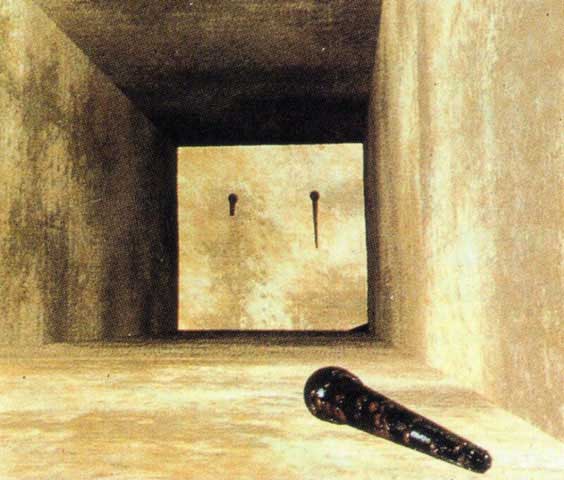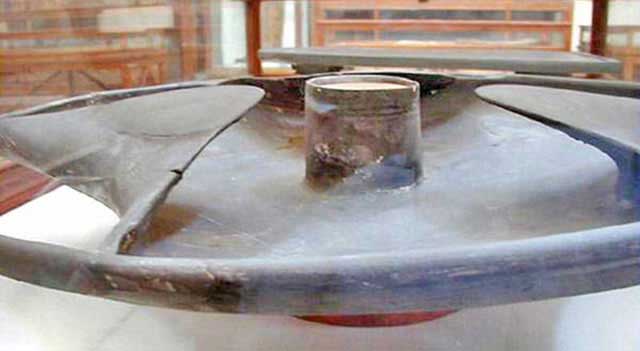Ancient Enigmas and Anomalies - Ancient Enigmas and Anomalies - Page 2
4. The concavity of the walls of the Great Pyramid
A photograph rather fortuitously snapped by Brigadier General Groves and first published in 1929 shows the vertical bisection of one of the sides of the Great Pyramid as revealed by the sun illuminating only one half of this side. The Great Pyramid therefore actually has eight sides, not four, but this hollowing-effect is not visible to the naked eye. It does not exceed 37 inches on any face of the pyramid. Why would a tomb for a pharaoh have been designed to have concave sides?
Figure 16. Photograph showing vertical bisection of the south side of the Great Pyramid [Temple, The Crystal Sun]

Figure 17. Satellite image of the Great Pyramid, bisected left side clearly visible.
5. An escape route for the soul of the King?
The Great Pyramid remains one of the greatest mysteries ever. Its internal construction is precise beyond comprehension, yet the official reason for its very existence remains that it was meant as a tomb for a king. Several shafts were cut with utmost precision at oblique angles through tons of stone. Orthodox Egyptologists maintain that these shafts were an escape route for the soul of the king. A robot with a camera was sent up one of these shafts, only to discover that it was blocked by a small door (see below). A hole was later drilled through this door, only to find another on the other side. Could this really have had anything to do with the soul of a king having to pass up this shaft? Surely, as argued by many, there must be a scientific reason for the existence of the pyramids!

Figure 18. Internal structure of the Great Pyramid [Luberto, The Great Mysteries of Archaeology - The Pyramids]

Figure 19. A ‘door’ blocking a Great Pyramid shaft as filmed by a robot equipped with a camera [Von Daniken, Return of the Gods].
Read more about the secret doors here. Some interesting statistics and calculations on the volume and number of stone blocks in the Great Pyramid can be found here and here.
6. Marvellous Masonry
Apart from the Great Pyramid itself, numerous ancient structures have been found with masonry that is simply mind boggling. How did the ancients manage to transport these massive blocks of stone and cut it so accurately and seemingly effortlessly?

Figure 20. A 120-ton stone in a wall at Sacsayhuaman, Cuzco, Peru [Alford, Gods of the New Millenium]

Figure 21. A 12-angled stone at Sacsayhuaman, Cuzco [Alford, Gods of the New Millenium]

Figure 22. Jigsaw puzzle in stone, Sacsayhuaman, Cuzco [Images of Anthropology]
These megaliths at Ollantaytambo, Peru, were cut from a porphyry quarry 8km away and 900m above this site, on the opposite side of a river valley. The blocks, on average 1x2x3.8m in size (mass about 19 tons), therefore had to be transported that far, down to the valley floor, across the river and then up a steep slope to Ollantaytambo.

Figure 23. Ollantaytambo megaliths [Hancock and Faiia, Heaven’s Mirror]
Why go to all this trouble, unless it was relatively easy to do? Can we repeat this exercise today without the use of modern machinery? 
Figure 24. “The absurdly difficult method of fitting the great granite blocks together” [Picknett and Prince, The Stargate Conspiracy]
These blocks almost appear to have been finished off in situ.

Figure 25. Unfinished obelisk (42m, 1200 ton) at Aswan [Parry, Engineering the Pyramids]
How did they plan to raise and transport this obelisk? What was this to be used for?

Figure 26. Baalbek foundation blocks

Figure 27. Baalbek monolith
A newly discovered megalith at Baalbek literally outweighs anything similar discovered so far – a block of stone measuring 19.6 x 6.0 x 5.5 meters with an estimated mass of 1650 tons (Figure 27a) – read more here. Scientists agree that the ancients had every intention to lift this block as one piece – how would they have been able to so?

Figure 27a. Baalbek megalith weighing 1650 tons, with Graham Hancock
How, when, who, what for? Why was this technology lost?
7. Drilling, cutting and machining of stone
At numerous ancient sites evidence has been found of stone blocks that have been ‘machined’, drilled or cut with high accuracy that seemingly would require 20th century tools and equipment. Some of these are shown below.

Figure 28. A carved stone at Puma Punku displaying a precision-made 6mm wide groove with equidistant drilled holes [Alford, Gods of the New Millenium, Ingold]
As recorded originally by Flinders Petrie in 1883, the Egyptians had made use of tubular drills to cut into materials like granite and other types of stone: “These tubular drills vary in thickness from 1/4 inch to 5 inches in diameter, and from 1/30 to 1/5 inch thick. The smallest hole yet found in granite is 2 inch diameter." "...there is a still larger example, where a platform of limestone rock has been dressed down, by cutting it away with tube drills about 18 inches diameter; the circular grooves occasionally intersecting, prove that it was done merely to remove the rock.”
It is unthinkable that such an advance technology could have existed in ancient times. Why is there no trace of such machinery to be found, yet ample evidence of its former existence does exist? Technology developed by a nation or group of people will continue to be developed and expanded, but a less advance civilization who have not mastered the basic principles will in time lose this technology.

Figure 29. Tube-drilled hole in granite [Lawton and Ogilvie-Herald, Giza the Truth]

Figure 30. Tube-drilled piece of granite displaying spiral grooves characteristic of tube-drilling [GEP, details below].

Figure 31. Granite drill-core [Lawton and Ogilvie-Herald, Giza the Truth]

Figure 32. Drill hole at the Aswan quarries, 12 inches in diameter and 3 feet deep [GEP].
Today this can be done with relative ease, but requires sophisticated power tools.

Figure 33. Core drilling at Abusir [Ingold]
The ancients also seem to have mastered a method to saw through rock and stone, as shown in the image below. There is no indication of the ‘wobbling’ of the blade that would be associated with a hand-drawn saw. It rather represents the saw marks left by a rotating blade held steady.

Figure 34. An example of saw grooves found in basalt blocks close to the Great Pyramid [GEP]

Figure 34.b Additional examples of extreme masonry, from Giza and South America by Lee Anderson (Thanos5150) at GHMB.
All done with ropes and primitive copper tools, of course.
The ancient Egyptians had the technology to machine vases and other objects from the hardest materials and in ways that we cannot perform today. The vase below is described as follows [GEP]:
“At least one piece is so flawlessly turned that the entire bowl (about 9 inches in diameter, fully hollowed out including an undercut of the 3 inch opening in the top) balances perfectly (the top rests horizontally when the bowl is placed on a glass shelf) on a round tipped bottom no bigger than the size and shape of the tip of a hen's egg! This requires that the entire bowl have a symmetrical wall thickness without any substantial error! (With a base area so tiny - less than .15 square inches - any asymmetry in a material as dense as granite would produce a lean in the balance of the finished piece.) This kind of skill will raise the eyebrows of any machinist. To produce such a piece in clay would be very impressive. In granite it is incredible.”

Figure 35. Description of incredible machining accuracy in granite [GEP]
Other extraordinary objects include a ‘horn’ of schist, a brittle type of rock, machined to have paper-thin edges, an asymmetric schist bowl with ‘lobes’ (an ancient propeller?) and an ‘ornamental toilet tray’ of equal complexity. How did the ancient Egyptians manufacture these, and why was the technology lost? It would be a challenging task for any modern machinist working with aluminium, not to mention stone! 
Figure 36. Schist horn with paper-thin edges [GEP]
Figure 37. Tri-lobed schist bowl in Cairo Museum [Lawton and Ogilvie-Herald, Giza the Truth, John Reid]

Figure 38. Schist Bowl [Bodsworth, The Egypt Archive]
Figure 39. Schist bowl asymmetry [Sakovich]

Figure 40. ‘Ornamental toilet tray’ and representation of missing centre portion [Bodsworth, The Egypt Archive]
An excellent overview of ancient stone technology in Egypt can be found here. The images referenced as [GEP] come from this website, where many more examples and details regarding the pyramids and other structures are presented. As summarized on this website, the technologies employed by the ancient Egyptians included the following:
- They had tube drills - drill bits and the machinery to hold them steady and apply rotational torque.
- They had saws that would cut granite with ease and precision.
- They had the ability to sculpt the hardest of rocks.
- They were accomplished at finishing granite in situ - after a block had been placed in a wall or on the surface of a pyramid.
- They had the ability to cut, level and polish granite to a sophisticated degree of flatness.
- They had lathes that would turn and polish granite, schist, basalt, etc (in ways we have not duplicated).
- They had the means to cut extremely accurate parallel limestone joints with remarkable flatness over large surface areas - 35 sq.ft.or more, and apparently had mastered the technique before beginning the casing of the Great Pyramid at Giza.
- They had the knowledge and technology to consistently lift, exactly maneuver and delicately place enormous weights of stone.
- They had the means and motivation to quarry and move millions of stone blocks.
The Egyptian reliefs shown below have been interpreted by many as some kind of a power tool (a power drill?) or as ‘lights’. Whatever it represents, it does appear to be some kind of instrument. It is possible that the serpent symbols may indicate ‘serpent power’ and the size of the operators compared to the other human beings suggests that the operators may have been regarded as ‘gods’ or ‘giants’.
Figure 41. Egyptian “Power Tools” [Childress, Technology of the Gods]

Figure 42. “Dendera lights” [Ingold]
The photographs below show imprints of what must certainly be metal clamps intended to join these blocks of stone. Scanning electron microscope studies have revealed that the clamps were poured molten into the imprints, requiring a portable smelter, and a spectrographic analysis of a clamp found in Bolivia revealed that it contained 1.7% nickel, of which there is no source in Bolivia.

Figure 43. Ancient metal clamps (TL Dendera Egypt, TR Angkor Wat Cambodia, BL Tiahuanaco, BR Ollantaytambo, Peru) [Hancock and Faiia, Heaven’s Mirror]
Figure 44. Puma Punku andesit stone block (note the clamp indentations)
Why was this technology lost?
An extensive and well worth reading overview of techniques that may have been used by Egyptians to work these stones can be found here, under the topics
Rock Properties: Why the ancient Egyptians can carve rock with stone and copper tools.
Ancient Egyptian Materials: Greywacke (schist)
Ancient Egyptian Stone Vessel Making
Ancient Egyptian Copper Slabbing Saws
Ancient Egyptian Copper Coring Drills
The Tomb of Sabu and the Tri-lobed Ornamental Bowl
Whether these methods could realistically have been used as proposed will be left for the reader to decide. The question nevertheless remains – why had this technology been lost? Had it been invented by the Egyptians a couple of millennia ago, surely they would have continued improving these technologies in much the same manner that integrated circuits (‘chips’) for computers and numerous other modern sciences continue to become more advanced with each passing year. Why do foreigners today have to attempt to unravel the mysteries of ancient Egyptian technologies if these had been invented by the Egyptians themselves?
- Hits: 118953